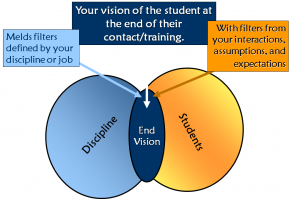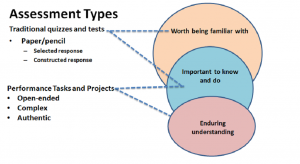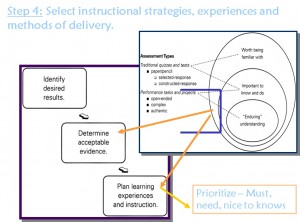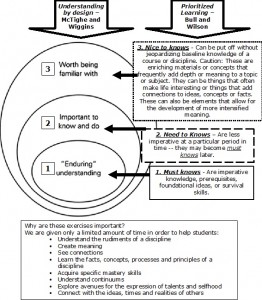When backwards curricular design is forward thinking: An overview of the backwards design development process
Questions and more questions
©Leslie Owen Wilson Ed. D.
How to construct curriculum using a “Backwards Design” process:
In writing curriculum or developing instructional tasks the following elements need to be considered. To use a visual metaphor, if you have ever seen pictures in old anatomy or geology books they used mylar (clear plastic) pictures to show the individual layers of topography, or parts or systems of the human body. And so viewers only got the whole picture when all the layers were properly sequenced, and stacked one on top of the others.
Writing curriculum is a similar, layered process until the instructional design becomes a clear, whole picture. While backwards design is an excellent way to construct curriculum and instruction, it is just one way and there are many other very effective ways to do the same thing. What should be part of all instructional design is the development of some guiding end vision of learners at the end of educational contact.
McTighe and Wiggins (2005) have become very popular authors from the publication of their book for ASCD, Understanding by Design, Expanded 2nd edition. In it they suggest that in crafting educational experiences one determines:
- Stage 1. What is worthy and requiring of understanding?
- Stage 2. What is evidence of understanding?
- Stage 3. What learning experiences and teaching promote understanding, interest, and excellence?
I suggest a little different sequence as their questions should be combined with your vision of your exiting learners.
Wilson – Step 1: Crafting a vision of your learners at the end of their contact with you. In creating this vision keep in mind:
- All instruction should be measured against what you know about your learners and how the information, processes, and/or skills you are going to teach are relevant or important to both the understanding and perpetuation of your discipline, and/or to the learners themselves and their futures.
- You need to learn to keep abreast of generational profiles, social and cultural trends, and demographics which will enable you to better contextualize information and learning experiences so that they are meaningful and connected to learners’ lives and backgrounds.
- You should also be somewhat familiar with things like instructional technology, learning styles, and what neuroscience tells us about how the brain actually learns and retains information so that you can construct effective instructional experiences.
- Too, it is important that you test your end vision of your learners against all stages of your instructional design and learning experiences to make sure they are compatible.
- Do your learners have visions of themselves? Older or mature students often have future visions of themselves. Have you spoken with them about how they see themselves in the future? What do they want to be or do, and then try melding your vision and theirs ?
Major question that should direct instruction: What is your vision of your learners at the end of their contact with you?
Click to enlarge – Diagram 1.1, L. Wilson
Creating Curriculum with Backwards Design – Intersections
These types of questions should be asked in forming your end vision of your learners:
- Specifically what skills will they have?
- What will they be able to do, and at what level of mastery?
- What will they know and understand?
- How will they have changed? How will their thinking, feelings, or physical movement or abilities have changed?
- What is your image of the learners? Are they active or passive participants in the learning process?
- What expectations do you have of entering learners? (pre-assess)
- What awareness do you have of the culture and history of your learners?
- How do students learn best?
- What instructional techniques and models work well and fit your content and learners best?
Wilson – Step 2: Determine what is worthy of teaching and learning.
Some of the following have been adapted or modified from McTighe and Wiggins, and should help in selecting and crafting educational experiences. One needs to determine:
- What information is worth knowing?
- What enabling knowledge (facts, concepts, and principles) and skills (procedures) will students need to perform effectively and achieve desired results?
- What activities will equip students with the needed knowledge and skills?
- What will need to be taught and coached, and how should it best be taught, in light of performance goals?
- What is worthy and requiring of understanding?
- What is enduring and/ or at the heart of the discipline/position?
- What needs uncoverage? (Uncoverage means to unearth, expose, to bring to light. Wiggins and McTighe devote a lengthy discussion to this concept and explain uncoverage as “Bring to the surface and bring to light the misunderstood, the subtle, the nonobvious, the problematic, the controversial, the obscure, the missing, and the lost.” In essence you are making students think at deeper and broader levels. (102))
- What learning and content promotes not only understanding, but interest, and excellence?
- What learning experiences and content are potentially engaging?
- What is evidence of understanding?
- What materials and resources are best suited to accomplish these goals? (This is especially important if you are offering your course online as techniques translate differently according to venue.)
- Is the overall design coherent and effective?
Selected filters that will help you decide what understandings (content, processes, and skills) and information to select.
They should:
- Offer potential for engaging [inspiring or challenging] students
- Represent a big idea having enduring value beyond the classroom
- Reside at the heart of the discipline (involve “doing” the subject)
- Require uncoverage (abstract or often misunderstood ideas).
[*Note: Addressing the “uncoverage” concept more fully, I would add ideas or concepts that are in flux, in the process of changing or becoming — especially if these projected changes are due to new discoveries, findings, information, research, or areas where ideas are being fully synthesized into new frameworks or theories. By anticipating these ideas and bringing them into the mix, you are better able to both anticipate change and prepare students for their futures. L.Wilson]
Wilson – Step 3:What is evidence of understanding – how will you evaluate students’ progressions toward your vision?
Click to enlarge
Creating Curriculum with Backwards Design -Assessments – Diagram from: Wiggins and McTighe
It is also imperative to think about the types of assessments that determine or give evidence of learning during this process.
Wilson – Step 4: Select instructional strategies, experiences, methods, or models of teaching and learning for delivery.
To include prioritizing learning goals or objectives according to importance. This process allows you to accelerate or remediate learning pathways through content or process more easily, especially if limited timeframes for instruction are an issue.
Click to enlarge – Diagram from: Wiggins and McTighe
Prioritize learning experiences
Click to enlarge
Creating Curriculum with Backwards Design – Prioritizing – Click to enlarge – Diagram 1.2, L. Wilson
Wilson – Step 5: Reflect, review, evaluate, and revise. This should be a continual process.
Why are these exercises important? We are given only a limited amount of time in order to help students:
- Understand the rudiments of a discipline
- Create meaning and explore meaning making at personal levels
- See connections
- Learn facts, concepts, and processes
- Acquire skills
- Understand cycles and continuums
- Develop an appreciation for the discipline
- Explore avenues of expressions of selfhood
- Learn to be problem solvers and problem finders
Teaching focused on what students will look like in the end, lead to types of quality learning experiences that actively engage students and propel them into knowing subjects at deeper levels.
Sources:
(As these hotlinks take readers to Amazon, the FTC requires me to indicate that they qualify as ads)
Wiggins, G. and McTighe, J. (2005) Understanding by Design, 2nd edition. Alexandria, VA: ASCD -(Association for Supervision and Curriculum Development)
Wilson, L. O. (2000) Course Packet from ED 721 – Fundamentals of Curriculum, UWSP, unpublished
Other books in the series:
Wiggins, G. and McTighe, J. (2011) The Understanding by Design Guide to Creating High-Quality Units 1st Edition. Alexandria, VA: ASCD (Association for Supervision and Curriculum Development)
Wiggins, G. and McTighe, J. (2014) Understanding by Design Guide Set (2 books) Paperback. Alexandria, VA: ASCD -(Association for Supervision and Curriculum Development)
** FTC Notice: For readers’ convenience throughout this site I have placed hotlinks to Amazon for a wide variety of books that relate to the topics discussed. Many of these books I have read, while others I not only read but purchased for my own professional collection. Other entries were recommended by folks I respect. In compliance with the United States FTC, I am required to tell readers that if they use the provided hotlinks to purchase linked materials, then I receive a very, very, very small commission from Amazon. These monies I use to help offset my website hosting fees.
If you want to know more about how to construct usable curriculum, you may be interested in these pages.




